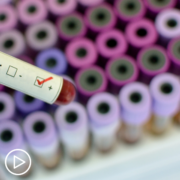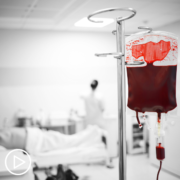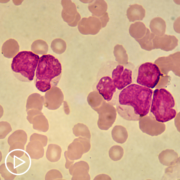A Look at Lower Intensity Chemotherapy in Untreated AML
A Look at Lower Intensity Chemotherapy in Untreated AML from Patient Empowerment Network on Vimeo.
Dr. Naval Daver from the University of Texas MD Anderson Cancer Center discusses whether untreated acute myeloid leukemia (AML) can be treated with lower intensity chemotherapy.
[ACT]IVATION TIP from Dr. Daver: “Ask your physician and your oncologist when you’re talking with them about what all the newest therapies are and what would be specifically the best treatment for their specific leukemia with respect to the different mutations.”
Download Resource Guide en español
Related Resources:

|

What Does Transfusion Burden Mean in Acute Myeloid Leukemia? |

|
Transcript:
Art:
Dr. Daver, what are we learning about patients with untreated AML who are ineligible for intensive chemotherapy? Will intensive chemotherapy, a thing of the past, in the near future?
Dr. Naval Daver:
There has been a major shift over the last four or five years towards using lower intensity combinations, such as azacitidine (Onureg or Vidaza) and venetoclax (Venclexta) and patients who are definitely about 75 and not fit for intensive induction. I don’t think anybody debates in that population, but even in patients 60 to 75 years away, you are borderline, and maybe we could give intensive induction chemotherapy and get patients to through it with support of care, antifungals, antibiotics by close monitoring, but we’re seeing similar remission rates with azacitidine (Vidaza), venetoclax (Venclexta), much less toxicity, less mortality, and especially the goal is to get a number of these patients to allogeneic stem cell transplant, which it is.
Then we feel that the lower intensity, better tolerated, smoother remission getting patients in a good condition an allogeneic transplant may be the way to go now, of course, to really make the standard of care, we have to look at this in a randomized fashion to make sure that what we believe is actually what the data is going to confirm, so there is an ongoing randomized study looking at the azacitidine and venetoclax intensity versus the traditional intensive chemotherapy called three plus seven in patients 18 to 65 years of age, and that…then you will, I think, give us a lot of information and data as for whether we can start for placing intensive chemotherapy for a large proportion or majority of AML patients, even those who are younger.
Today, I don’t think that in terms of chemotherapies are a thing of the past, I think those patients who are below 60 or even those who are 60 to 65, who are routinely doing intensive induction chemotherapy, one has to realize that the five-year survival for many molecular subsets are close to 50 to 60 percent with intensive induction chemotherapy, whereas with HMA venetoclax in the older unit, we’re looking at three to five-year survival rates of about 30 percent, so we have still not seen data and younger patients with Hamas to be convinced that this will replace intensive chemotherapy altogether, I think the signal suggests that there is a potential for it to do so, especially with the use of allergenic tensor as plan, which we’re using quite frequently and…or maintenance.
But that has not yet been established. So I would still say we do use intensive chemo in those who are young and fit, so my activation tip for this is that there has been a lot of progress in the lower intensity therapies over the last six or seven years.
A decade ago would not even be asking whether there’s anything that can replace intensive chemo today we do have data with HMA venetoclax that suggest that it may be as good as intensive chemo looking at the response rates MRD negativity, and especially with three drug combinations where adding targeted therapies to HMA venetoclax, those response rates and depth of response looking as good, if not better, than intensive chemo there are randomized studies ongoing that are going to be looking at intensive chemotherapy versus HMA venetoclax and if those show equivalents or superiority for HMA venetoclax, I think in the next five, six years there will be a huge shift towards less use of intense and chemotherapy in the frontline setting, but we’re not there yet.



